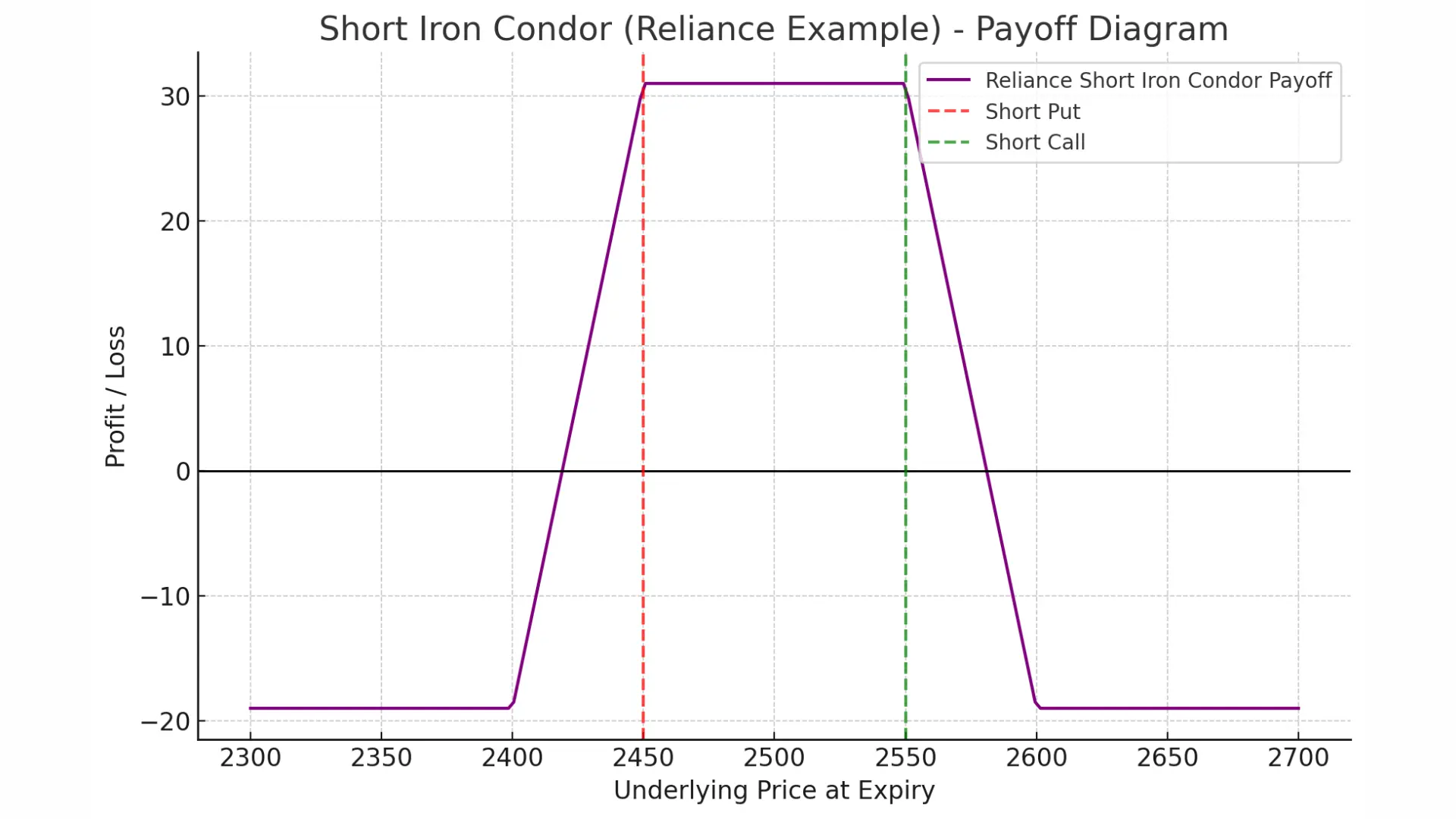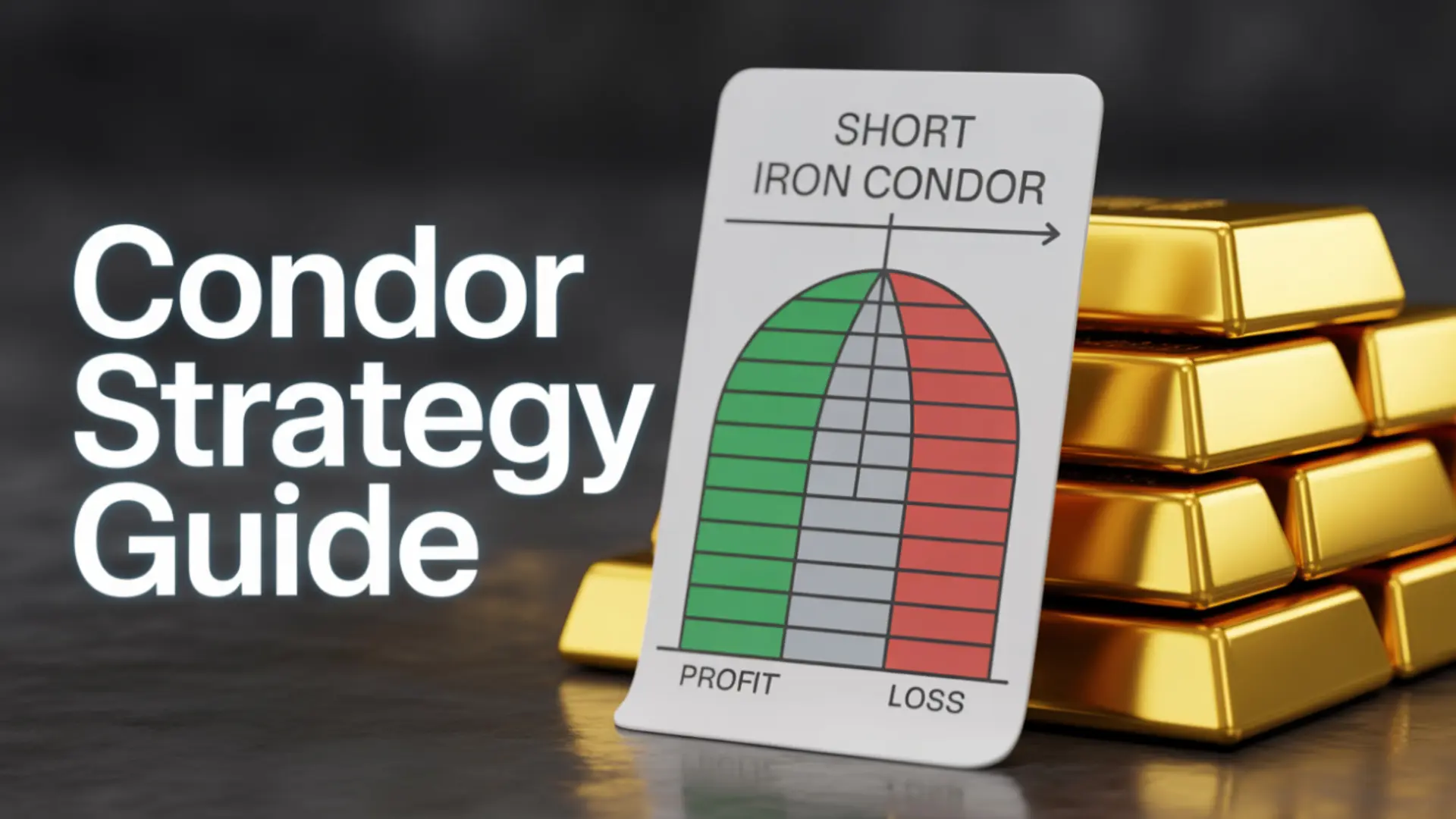Table of Contents
- Introduction
- What is a Short Iron Condor Strategy?
- How Does the Short Iron Condor Work?
- Payoff Structure
- Example 1: NIFTY Short Iron Condor
- Example 2: Reliance Short Iron Condor
- Advantages
- Risks Involved
- Key Takeaways
- FAQs
- Conclusion
A practical, step-by-step guide to the Short Iron Condor strategy with payoff math, examples on NIFTY & Reliance, advantages, risks, and FAQs.
Introduction
Options trading is full of unique strategies designed to help traders profit in specific market conditions. One of the most popular neutral-to-range-bound strategies is the Short Iron Condor, also known as the Short Call Condor. This strategy aims to benefit when the market moves sideways within a defined range, making it a solid choice for low-volatility scenarios.
In this article, you’ll learn what a Short Iron Condor is, how it works, its profit/loss potential, advantages, risks, and two practical examples so you can apply it with confidence.
What is a Short Iron Condor Strategy?
A Short Iron Condor is a limited-risk, limited-reward credit options strategy built by selling one call spread and one put spread on the same expiry. The goal is to collect premium and keep the underlying price between the two short strikes until expiration.
Use it when:
- You expect low volatility.
- The underlying is likely to remain range-bound.
- You want defined risk and steady premium income.
How Does the Short Iron Condor Work?
The setup has four legs (all with the same expiry):
- Sell 1 OTM Call (lower call strike)
- Buy 1 OTM Call (higher call strike)
- Sell 1 OTM Put (higher put strike)
- Buy 1 OTM Put (lower put strike)
The two short options create the profit zone. The two long options (farther OTM) cap your maximum loss.
Payoff Structure
| Metric | Formula | Notes |
|---|---|---|
| Max Profit | Net credit received | Occurs if price closes between the short put & short call strikes. |
| Max Loss | Spread width − net credit | Occurs if price moves beyond either long option’s strike at expiry. |
| Lower Breakeven | Short Put Strike − net credit | Below this, losses begin on the downside. |
| Upper Breakeven | Short Call Strike + net credit | Above this, losses begin on the upside. |
Example 1: NIFTY Short Iron Condor
Assume: NIFTY at 22,000 and expected to remain range-bound.
- Sell 1 NIFTY 22,200 Call @ ₹120
- Buy 1 NIFTY 22,400 Call @ ₹70
- Sell 1 NIFTY 21,800 Put @ ₹110
- Buy 1 NIFTY 21,600 Put @ ₹60
Net Credit = (120 − 70) + (110 − 60) = ₹100
| Max Profit | ₹100 × Lot Size |
| Max Loss | (₹200 spread width − ₹100 credit) × Lot Size = ₹100 × Lot Size |
| Profit Zone | Between 21,800 and 22,200 |

Here’s the Payoff Graph for the Short Iron Condor (NIFTY Example):
The flat middle section shows the profit zone where maximum premium is earned (between 21,800 and 22,200).
Losses start once the price breaks below 21,800 or above 22,200, but the risk is limited by the long call and long put positions.
Example 2: Stock-Based Short Iron Condor (Reliance)
Assume: Reliance at ₹2,500, expected to remain stable.
- Sell 1 Reliance 2,550 Call @ ₹30
- Buy 1 Reliance 2,600 Call @ ₹15
- Sell 1 Reliance 2,450 Put @ ₹28
- Buy 1 Reliance 2,400 Put @ ₹12
Net Credit = (30 − 15) + (28 − 12) = ₹31
| Max Profit | ₹31 × Lot Size |
| Max Loss | (₹50 spread width − ₹31 credit) × Lot Size = ₹19 × Lot Size |
| Profit Zone | Between ₹2,450 and ₹2,550 |

Here’s the Payoff Graph for the Reliance Short Iron Condor Example:
Profit zone lies between ₹2,450 and ₹2,550, where the trader earns the maximum premium.
Losses are capped outside this range, thanks to the protective long call and long put options.
Advantages of Short Iron Condor
- ✅ Limited risk and limited profit.
- ✅ Ideal for range-bound, low-volatility markets.
- ✅ Works well on indices like NIFTY & BANKNIFTY.
- ✅ Good for premium income with defined risk.
Risks Involved
- ⚠️ Losses occur if the price moves beyond the breakeven.
- ⚠️ Profits are capped; not suitable for strong trending markets.
- ⚠️ Requires careful strike selection, risk limits, and monitoring.
Key Takeaways
- The Short Iron Condor is a neutral, credit strategy for low volatility.
- Max profit = net credit, realized if the price stays between the short strikes.
- Max loss = spread width − credit, if price breaks out strongly.
FAQs on Short Iron Condor Strategy
Q1. Is Short Iron Condor the same as Short Call Condor?
Yes. Both terms describe the same strategy: selling an OTM call spread and an OTM put spread to collect premium with defined risk.
Q2. What’s the difference between Long and Short Iron Condor?
Short Iron Condor (credit) profits from low volatility/range-bound movement. Long Iron Condor (debit) is a wager on higher volatility; it benefits if the price moves far enough beyond the breakeven levels.
Q3. Can beginners trade this strategy?
It’s better for intermediate traders because it has four legs and requires selecting strikes thoughtfully, but with practice and strict risk limits, beginners can learn it.
Q4. What is the maximum loss in a Short Iron Condor?
Maximum loss equals the spread width minus the net credit received. It happens if the price finishes beyond the long call (upside) or long put (downside) at expiry.
Conclusion
The Short Iron Condor is a smart, neutral strategy for traders who expect the market to stay within a range. With defined risk and a straightforward payoff, it’s ideal for low-volatility periods, earnings lulls, or when technicals suggest consolidation. As always, size positions responsibly and manage risk around major events.
Tags: Short Iron Condor, Short Call Condor, Options Strategy, NIFTY, Range-Bound, Low Volatility

